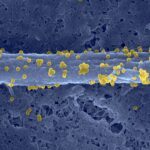Lien vers Pubmed [PMID] – 18061598
Int. J. Parasitol. 2008 Jun;38(7):757-73
Amphipathic alpha-helices have been proposed as the general means used by soluble proteins to induce membrane tubulation. Previous studies had shown that the GRA2 dense granule protein of Toxoplasma gondii would be a crucial protein for the formation of the intravacuolar membranous nanotubular network (MNN) and that one of the functions of the MNN is to organise the parasites within the parasitophorous vacuole. GRA2 is a small protein (185 amino acids), predicted to contain three amphipathic alpha-helices (alpha1: 70-92; alpha2: 95-110 and alpha3: 119-139) when using the standard programs of secondary structure prediction. To investigate the respective contribution of each alpha-helix in the GRA2 functions, we used DeltaGRA2-HXGPRT knock-out complementation: eight truncated forms of GRA2 were expressed in the deleted recipient and the phenotypes of these mutants were analysed. This study showed that: (i) alpha3, when associated with the N-terminal region (NT) and the C-terminal region (CT), is sufficient to target the protein to the parasite posterior end and to induce formation of membranous vesicles within the vacuole. However, when associated only with CT, alpha3 is not sufficient to provide the hydrophobicity required for membrane association; (ii) the alpha1alpha2 region is alone not sufficient to induce membrane tubulation within the PV; and (iii) only one mutant, NT-alpha1alpha2alpha3, restores most of the biochemical and functional properties of GRA2, including traffic to the dense granules, secretion into the vacuole, association with vacuolar membranes, induction of the MNN formation and organisation of the parasites within the vacuole.

